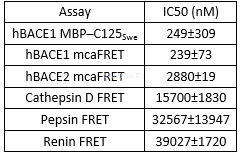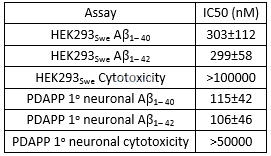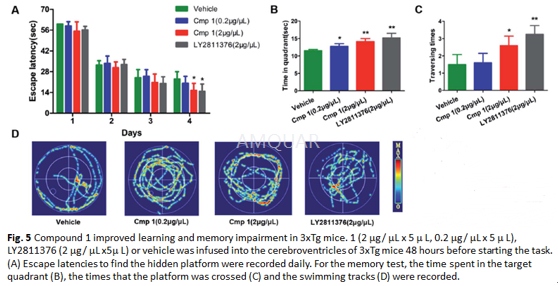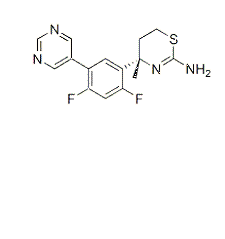-
生物活性
LY2811376 is a BACE1 inhibitor with marked Ab-lowering effects in animal models.
Potency of LY2811376[1]

FR: cell-free fluorescence polarization assays, WCA: whole-cell assay.
Potency of LY2811376in BACE1 and related aspartyl protease assays[2]

Potency of LY2811376 cellular APP processing assays[2]

-
体外研究
-
体内研究
-
激酶实验
BACE1 Enzyme Cell-Free Assay (FP)[1]
β-Secretase-1 activity was assessed with soluble BACE1 and the synthetic APP substrate biotin− GLTNIKTEEISEISYEVEFR-C [Oregon Green]KK−OH in the presence of compounds in a fluorescence polarization (FP) in vitro assay. Enzyme, substrate, and test compounds were incubated in 15μL of streptavidin. Fluorescence polarization was measured with a PerkinElmer EnVision plate reader (Ex485 nm/Em530 nm).
BACE1 enzymatic assay[3]
The enzyme inhibition assay was carried out using b-Secretase Activity Assay Kit from Abnova according to the manufacturer instructions and using a multi-well fluorescence plate reader that allowed absorption at 335-355 nm and recorded emission at 495–510 nm. The assay procedure was conducted as follows: the lyophilized Activeβ-secretase was reconstituted by adding 10 mL of ddH2O to make a working solution. 50μL lysate was added to each well in a 96-well plate. 50μL of 2x reaction buffer and 2μL ofβ-secretase substrate were added. The reaction mixtures were incubated in the dark at 37oC for 1 hour. Fluorescence was monitored at 334–355 nm (excitation wavelength) and 490–510 nm (emission wavelength).
-
细胞实验
Cell-based assays[2]
The human embryonic kidney cell line HEK293 stably expressing a human APP751 cDNA containing the naturally occurring double mutation N670L671, commonly called the Swedish mutation and shown to overproduce Aβ. PDAPP is a transgenic mouse animal model overexpressing a human APP mini-gene that harbors a familial mutation (APPV717F), which recapitulates much of the amyloid pathology observed in AD. Primary cortical neurons from embryonic day 16 PDAPP embryos were incubated in the presence/absence of inhibitors at the desired concentration. At the end of the incubation, conditioned media were analyzed for Aβpeptides by specific ELISAs as described in the section below.
Aβpeptides were measured by sandwich ELISAs, using monoclonal 2G3 as a capture antibody for Aβ1– 40, monoclonal 21F12 as a capture antibody for Aβ1– 42, and biotinylated 3D6 as reporting antibody (for description of Aβmonoclonal antibodies). Culture media was diluted to allow determination of Aβs within the range of standards (0 –1000pg/ml). For both cell culture systems, the concentration of Aβreleased in the conditioned media was considered reflective of BACE1 inhibition. The 10-point inhibition curve was plotted and fitted with the fourparameter logistic equation to obtain the EC50 or relative IC50 values for the compound effect.
-
动物实验
Animal experiments[3]
The animals were fed in a room under standard housing conditions (room temperature 24 to 27oC, humidity 60–65% and 12 h light–dark cycle) with free access to food and water. The mice were aged 4 to 5 months and weighed 20 to 25 g. The mice were divided randomly into four groups (n = 10 in each). The mice were anesthetized with 6% chloral hydrate (6 mL /kg, i.p.) and different solutions (compound 1 2μg /μL x 5μL, 0.2μg /μL x 5μL, LY2811376 2μg/μL x 5μL, DMSO 5μL as control) were infused very slowly into the cerebral ventricles of the mice with the following coordinates: 0.2 mm anterior to posterior (AP) bregma, 0.9mm midline to lateral (ML), and 2.3mm dorsal to the ventral (DV) dura. After 48 hours, a water maze was used to train and test the ability of spatial learning and memory of mice. After this procedure, which was carried out for 6 days, the mice were sacrificed and other tests were performed.
Morris water maze assay
The water maze used for the mice was a plastic, circular pool 2.1 m in diameter and 0.6 m in height that was filled with water (temperature at 25oC±1oC). A circular platform (13 cm in diameter) was placed at a specific location away from the edge of the pool. The top of the platform was submerged 1.5 cm below the water surface. Water was made cloudy by adding milk powder. Distinctive visual cues were set on the wall. For spatial learning and training, animals were subjected to four trials a day in the afternoon. The training procedure lasted a further 4 days and a total of 20 trials were performed. For each trial, the animal was placed at a different starting position, spaced equally around the perimeter of the pool. Animals were given 60 s to find the platform. If an animal could not find the platform, it was guided to the platform and allowed to stay there for 30 s. The time that each animal took to reach the platform was recorded as the escape latency. A probe trial of 60 s was carried out one day after the end of training to test memory retention. For the probe trial test, animals were placed in the pool with the platform removed and the time they spent in the target quadrant and the numbers of times that they crossed the platform’s location were recorded.

-
不同实验动物依据体表面积的等效剂量转换表(数据来源于FDA指南)
|  动物 A (mg/kg) = 动物 B (mg/kg)×动物 B的Km系数/动物 A的Km系数 |
|
例如,已知某工具药用于小鼠的剂量为88 mg/kg , 则用于大鼠的剂量换算方法:将88 mg/kg 乘以小鼠的Km系数(3),再除以大鼠的Km系数(6),得到该药物用于大鼠的等效剂量44 mg/kg。
-
参考文献
[1] Butler CR, Brodney MA, Beck EM, et al. Discovery of a series of efficient, centrally efficacious BACE1 inhibitors through structure-based drug design. J Med Chem. 2015;58(6):2678-2702.
more
分子式
C15H14F2N4S |
分子量
320.36 |
CAS号
1194044-20-6 |
储存方式
﹣20 ℃冷藏长期储存。冰袋运输 |
溶剂(常温)
|
DMSO
21 mg/mL |
Water
<1 mg/mL |
Ethanol
55 mg/mL |
体内溶解度
-
Clinical Trial Information ( data from http://clinicaltrials.gov )
| NCT Number | Conditions | Interventions | Sponsor/Collaborators | Phases | Start Date | Last Updated |
| NCT00838084 | Alzheimer's Disease | Drug: LY2811376|Drug: Placebo | Eli Lilly and Company | Phase 1 | 2008-12-01 | 2009-07-14 |
注:以上所有数据均来自公开文献,并不保证对所有实验均有效,数据仅供参考。
-
相关化合物库
-
使用AMQUAR产品发表文献后请联系我们





















